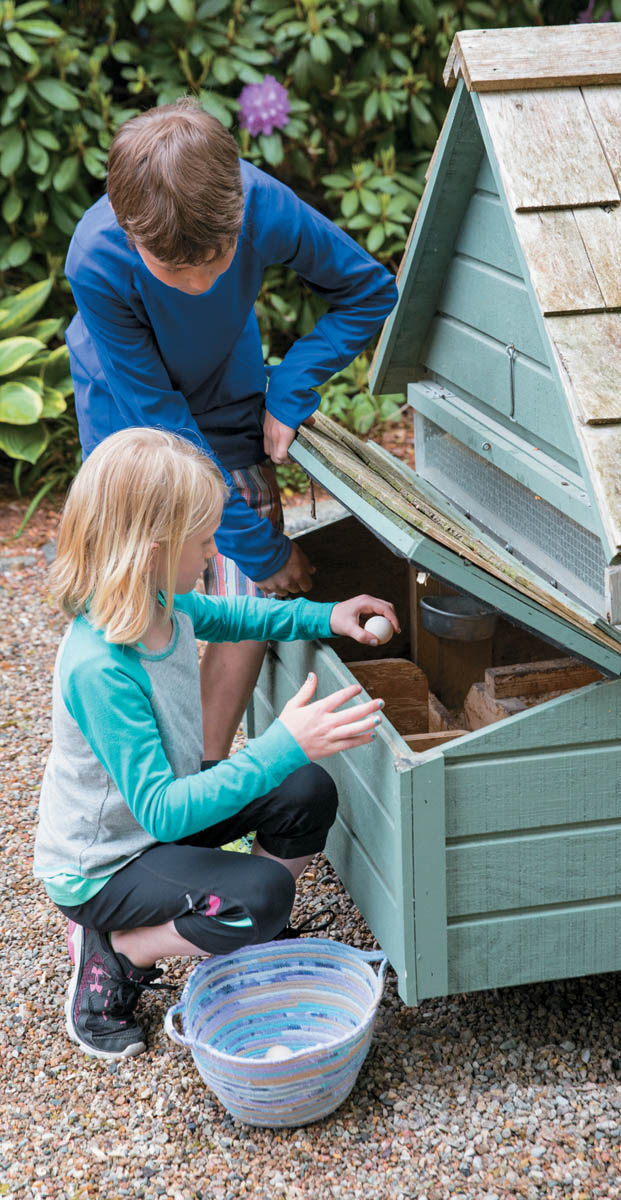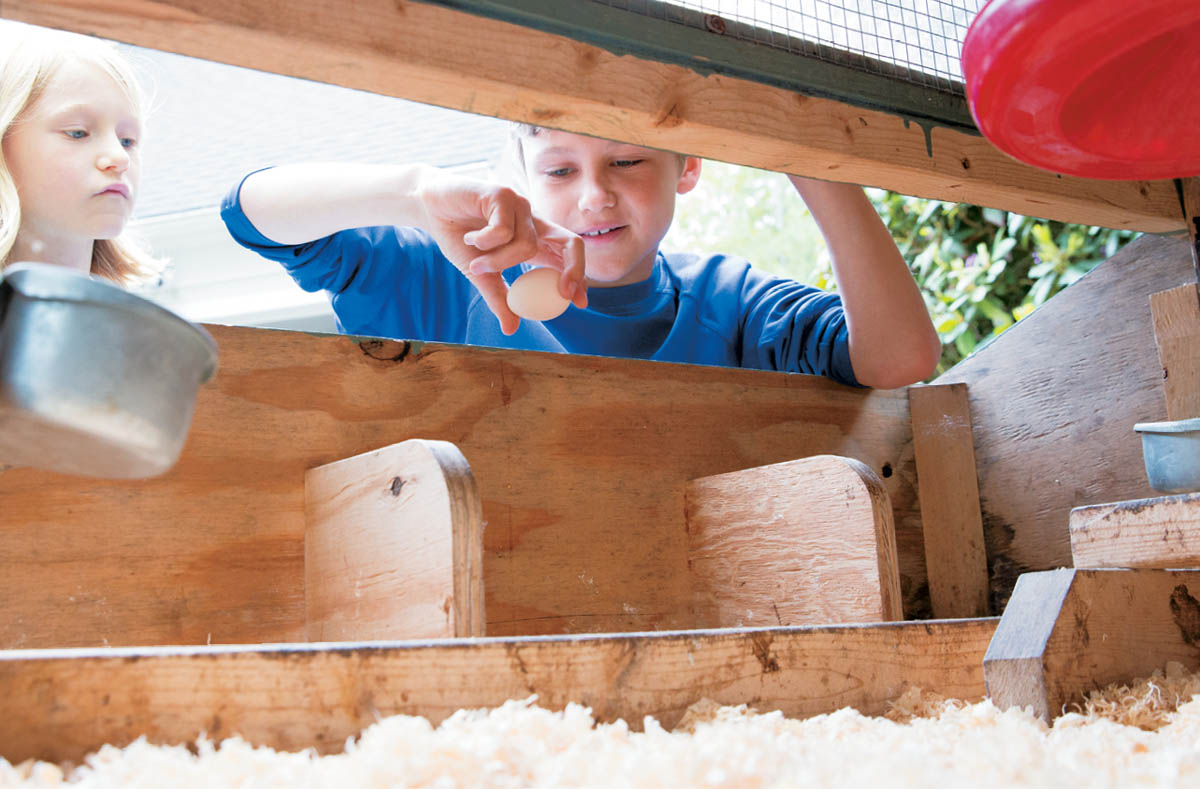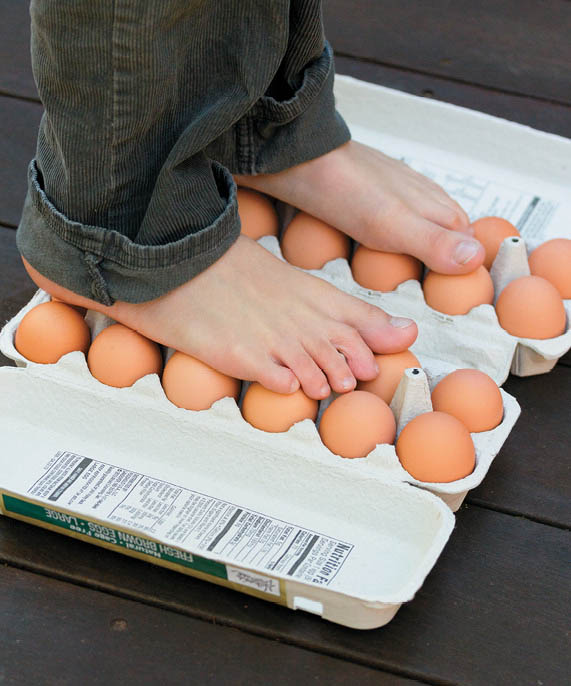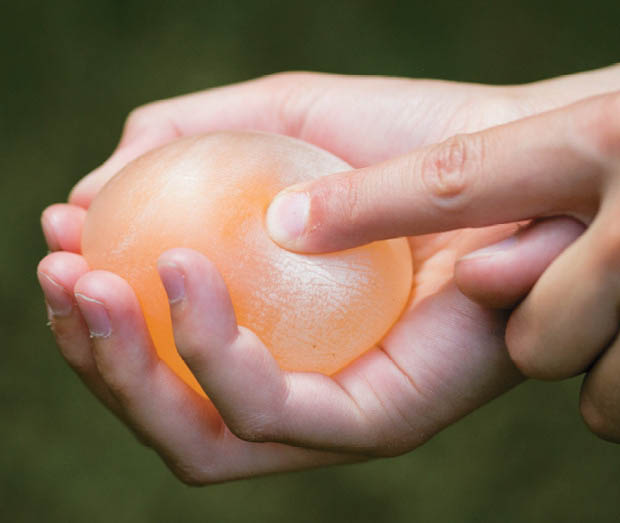
You have taken good care of your flock, and the hens are finally old enough to start laying eggs. You’ve noticed that their wattles and combs have become a deeper, richer shade of red as they mature. Some of them may even be sitting in empty nesting boxes, as if practicing for the big day.
If it seems as though it is taking forever for your chickens to lay their first eggs, you are not alone. I still remember discovering our first egg.
It was a fall afternoon, and I was the only one home. I was raking leaves when I heard a commotion. All of the chickens were out in the run and one of the Silkies was yelling loudly. They all seemed fine, so I checked the nesting boxes. When I lifted the lid, the entire flock hurried inside the coop — they were curious, too! There in the box was a tiny, sweet, warm egg.

Over the next several weeks, all of the girls started laying. The kids raced out to the coop after school to check for eggs and suddenly we had dozens of them in our fridge.
Bantam breeds typically start to lay eggs around 20 weeks of age, while the larger standard-sized hens, like Buff Orpingtons, begin closer to 24 weeks. Once a hen begins to lay eggs, she produces one approximately every 26 hours. This is how long it takes for an egg to form.
Some days every hen will lay an egg, but on other days, you might discover only one egg from the whole flock. Egg production depends on their nutrition, their health, their age, and the seasons. Chickens lay eggs their entire lives but are the most productive during the first two years of life. This is not always the rule, but it is true in most cases.
Each hen lays eggs that are unique to her. Of course the color is consistent for the breed, but the eggs will typically have a shape and tint that is recognizable. If you have only a few hens, catching them in the act of laying and figuring out which egg belongs to which chicken should be pretty easy. Make sure that all the hens in your flock are regularly laying eggs, as this is a very good indicator of their health. Stress-free, healthy, chickens lay eggs regularly.

When the pullets’ combs and wattles begin to turn a deeper shade of red, they are close to laying their first eggs.
You can usually tell what color eggs a hen will lay by the color of her earlobes. White lobes often mean white eggs and red lobes mean brown eggs!
We hung a small chalkboard in our coop to make it easy to keep track of egg production. It’s fun to know which hens have laid an egg each day. It’s also a good way to notice if one of them stops laying.


Harvest your eggs from the nesting boxes three times per day, if possible: in the morning, the afternoon, and right before closing them in at night. Keeping the nest boxes empty curtails broody behavior and prevents chickens from developing the bad habit of egg eating.
Carefully collect all eggs from the nesting boxes, using a small bowl or an egg-collecting basket to hold them. If a hen is in the box, you can gently reach underneath her from the front and see if she is sitting on any eggs — sometimes one box becomes a favorite with all the hens. Use caution, as you do not want to startle her, especially if she is laying an egg herself.
If you find a broken egg or if you break an egg, remove all the soiled litter and egg from the nesting box. You do not want chickens to discover how delicious their eggs can taste! Eating eggs doesn’t hurt the chickens, but it is distressing to watch, not to mention that you want all those eggs yourself!

Collecting eggs is a fun chore. You never know how many you’ll find!
If you have a rooster, it is especially important to collect eggs regularly on hot days, as fertilized eggs can start to develop at 85°F (29.4°C). Sometimes free-ranging hens will hide a nest of eggs away from the nesting boxes. If you find eggs outside the coop, you won’t know how old they are. To be safe, it’s best to discard them. The chickens will lay more.
Chickens may begin to eat eggs for a number of reasons. These include boredom, curiosity, or lack of protein. Once egg eating starts, it is very difficult to correct.
You can try to prevent it by harvesting eggs frequently, ensuring the hens are on a good layer feed, and providing them with oyster shells.
You can also switch to slanted nesting boxes, where the egg rolls into a compartment that the hens can’t reach. Or try filling a blown-out egg with mustard and leaving it as bait in the nesting box.
Before you assume that your hens are eating eggs, make sure that another sort of critter, like a snake, is not sneaking into the coop. Some predators leave the hens alone and go for the eggs.
If you keep your nesting boxes clean and do not let your chickens sleep in them, then your hens’ eggs should remain clean. If your nesting boxes are dirty, your eggs will be dirty. Develop the habit of tidying up the nesting boxes each morning when you open the coop up for the flock. A kitty litter scooper works wonderfully for scooping up chicken poop that is sometimes left in the nesting boxes.
One of the most important reasons to keep the nesting boxes clean is because you truly do not want to have to wash your eggs. Right before the hen lays an egg, she coats the entire shell with something called the bloom. The bloom keeps the egg fresh and helps prevent moisture, bacteria, fungi, and viruses from entering through the tiny pores in the eggshell. If you are harvesting eggs immediately after they have been laid, you might find an egg that is still wet. That’s the bloom! Give it a minute or two to dry before handling it.
If you come across a badly soiled egg, you can clean it, but because you will wash off the bloom, you should store that egg in the fridge and eat it sooner than ones with the bloom still intact.
To clean an egg, turn on the faucet and adjust the temperature of the water to about 10 degrees warmer than the egg. Wash the egg gently under the flowing water until it is clean, then immediately dry it off. Don’t submerge the egg in a bowl of water, which can promote bacteria passing through the shell. You don’t need to use anything but water to clean your eggs, although commercial egg wipes are available.

Eggs are usually quite clean if you collect them right away, but sometimes you have to wash dirt or poop off one or two.
As long as the eggs have not been washed and the bloom is still intact, you can keep them on the counter until they are ready for use or until space is available in the refrigerator. They can stay at room temperature for up to a week. Fertilized eggs, however, should be refrigerated, especially in warm weather.
You can, of course, refrigerate eggs if you prefer, and this is the law if you wish to sell them. Once eggs have been refrigerated, they must stay refrigerated — you can't take them out of the refrigerator later and store them at room temperature. Store eggs between 33° and 45°F (1°–7°C) in the interior of the fridge as opposed to on the door, where the temperature fluctuates too much. You can use egg cartons, but a kitchen bowl works nicely, too. Also, do not keep eggs near stinky foods, such as cut onions. They can absorb odors through their porous shells, which could affect their taste.
At some point, your neighbors and friends will probably ask if you sell your eggs. And you most certainly will have extra eggs if you are a family of four and keep more than six hens. The number of eggs will fluctuate as the seasons change, but it’s fun to load up a wagon with a cooler full of extras to sell to the neighbors (with your parents’ permission, of course).
You can also set up a little farm stand with a cooler and a cash box at the end of your driveway that works on the honor system. Just check with your town first to see if it has regulations regarding farm stands or any other rules about selling eggs.
Many factors can affect the number of eggs that you collect each day. Sometimes you have to be a detective to determine the cause. As mentioned earlier, the number of eggs will decrease as your flock ages, but if that’s not the reason, here are some questions to ask:
After your chickens are a year old, they will molt annually. Molting is the process that allows your chickens to replace their feathers. Usually it happens in the fall to replace old and worn-out feathers for the upcoming winter. However, chickens may spontaneously molt when they are stressed. Starting at the head, then the chest, wings, back, breast, and tail, the feathers begin to fall out. Sometimes my kids laugh when they see the chickens molt. One day the chickens look fine, the next day, feathers are everywhere. It looks like a chicken exploded in the coop!
Molting requires a great deal of protein. Since both feathers and eggs are made up almost entirely of protein, do not be surprised if your chickens stop laying eggs until their molt is complete, which can take up to a month.

It will take about a month for this molting hen to completely regrow her feathers.
During their molts, treat your hens to some high-protein snacks such as mealworms and sunflower seeds. You can also add some vitamins and electrolytes to their drinking water. Their main food source should continue to be their normal layer feed.
Making snacks for chickens is great fun! You can create so many fabulous combinations. Mix up a few of your concoctions from the suggested ingredients list below and make up names for your recipes. Keep notes on which ones are your flock’s favorites.
Mix up your chosen ingredients in a large lidded container. Treat your chickens to a handful of chicken trail mix as you like. Store it covered in a cool, dry place.

Every so often, a malfunction occurs in a hen’s egg-laying abilities. This can happen during any stage of her life. If you come upon a misshapen egg, just toss it away and monitor the next few eggs from that hen. Sometimes the problems are simply misfires, and other times they can indicate a more general health issue. If a health issue is the cause, you can intervene to help the hen return to normal egg laying.
You might think only rubber chickens lay rubber eggs, but eggs without shells are not uncommon when your hens first begin to lay, when they return to laying after molting, or as they age. Shell-less eggs are weird! They are soft and feel rubbery. The inner membrane of the egg is intact and what you pick up looks just like an egg except the shell is completely missing.
Eggs without shells are usually an indication that the hen is lacking calcium in her diet. To remedy this situation, be sure the flock has access to oyster shells or crushed eggshells. Also, be sure the flock is on a layer feed and that you are not feeding too many treats to your flock.
Sometimes hens will lay itty-bitty eggs, no larger than a quarter. These are called wind or fart eggs. Whichever name you prefer, these eggs are merely an “oops” in the hen’s egg-laying process. These eggs are typically yolkless, and sometimes your hen will lay a few of these in a row. Eventually, your hen’s egg laying should return to normal. You might find these eggs so cute that you want to blow them out to keep them! (See How to Blow Out and Decorate Eggs for directions.)
Sometimes, you will crack open a large egg to reveal not one but two eggs inside! These double yolkers are quite a surprise and are completely edible. Consider yourself lucky to have a hen who occasionally makes these. They are a backyard chicken keeper’s delight!
Eggs are great for eating, but you can also do some cool experiments with them. Here are just three fun things to do with a few extra eggs.
Can you drop an egg out of a second-story window without breaking it? Give it a try!
Wrap a few eggs in padded containers using household items such as bubble wrap, toilet paper rolls, egg cartons, string, plastic bags, and a water bottle to keep them safe. You can even try making a parachute!
Then drop the eggs out a second-story window. What happens? Which contraptions protect the eggs more?
Place two dozen eggs still in their cartons side by side and stand on top of them barefoot. What happens? Do they break? What do you think keeps them strong?

You can make a shell-less egg by placing a regular egg in a cup of white vinegar. Over the course of a few days, the vinegar will deplete the shell of calcium.
